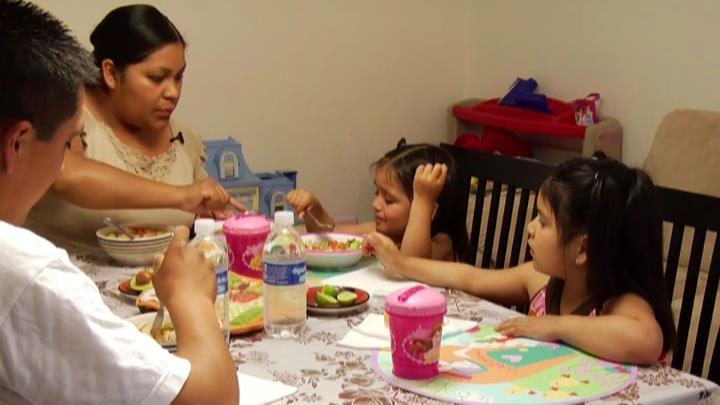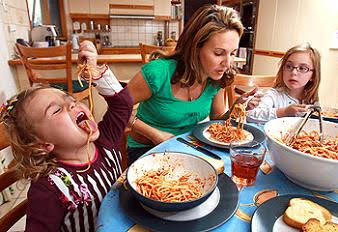
Family meals and snacks
Everybody does better with family meals
You know that family meals are important, and studies back up what you know
- Adults who have regular meals eat better, are healthier, and are slimmer.
- Children and teens who have family meals eat better, feel better about themselves, get along better with other people, and do better in school.
- They are less likely to gain too much weight, abuse drugs, smoke, and have sex.
- Family meals have more to do with raising healthy, happy children than family income, whether the child has one or two parents living in the home, after-school activities, tutors, or church.
- As children move through the teen years, families are more likely to eat on the run than have meals together.
More reasons to hold the line with family meals
- Meals help adults and children learn to like a variety of food.
- Meals let everyone go to the table hungry and eat until they get enough.
- Family meals help both adults and children eat the amount they need to weigh what is right for them.
- Meals give a time and place to do the work of the family: Keep up with what is going on with everyone; help each other out, tell family stories.
- Meals keep food in its place as only one of life’s great pleasures. You pay attention and enjoy it when it is time to eat, forget about it between times.
Sit-down snacks
Sit-down snacks are the ace in the hole of beleaguered parents and, in fact, of anyone who eats!
Consider these routines
- Your child gets down from the table having eaten little or nothing. He is back 5 minutes later, wanting a cookie.
- He seems perfectly comfortable with not eating much, but you worry that he won’t make it until the next meal.
- Your school-age child comes home famished and eats more or less continuously until dinner.
- Your lunch wasn’t too good or too filling. You happen to think ”cookie,” or ”soda,” or ”latte.”
- You were so busy at breakfast that you didn’t eat much and now you are starved.
The solution is the planned snack
- Snacks are little meals, not just treats or food handouts.
- Say to your young child (or to yourself), ”we just ate, but snack time is before long.”
- Say to your older child, ”sit down and eat your snack right now so you don’t spoil your dinner.”
Here is what to keep in mind about snacks
- Sit to snack, don’t allow yourself or your child to eat on the run or eat along with other activities.
- Have snacks be sustaining: Include 2 or 3 foods. Include protein, fat, and carbohydrate. Eat as much as you want; let your child do the same.
- Time snacks a long-enough time before the next meal so you or your child have time to get hungry again by mealtime.
- Include foods you didn’t get otherwise, such as vegetables or ”forbidden” food.
- Provide a sit-down bedtime snack, even if your child didn’t eat much at dinner. Make it something filling but not thrilling, such as cereal or crackers and 2% or whole milk (fat is sustaining).
Using “forbidden” food
”Forbidden” foods are high-fat, high-sugar, relatively low-nutrient foods such as sweets, chips and sodas.
Don’t restrict “forbidden” food
- You might be able to keep “forbidden food” away from your child when she is little, but not when she is older and out on her own.
- The idea is to allow your child to feel relaxed and be matter-of-fact about all kinds of foods.
- Then, even when you aren’t around to supervise, she will eat moderately of high-calorie, low-nutrient foods, the same as other foods.
- Research shows that children whose forbidden food intake is restricted eat more of them when they get the chance and are fatter than they might be otherwise.
Make wise use of ”forbidden” food
- Include chips or fries at mealtime, and arrange to have enough so everyone can eat their fill. Unlike sweets, fatty foods don’t compete with other mealtime foods.
- Put a serving of dessert (if you like dessert) at each person’s place. Let them eat it before, during, or after the meal. No seconds on dessert.
- Periodically offer unlimited sweets at snack time. For instance, put on a plate of cookies or snack cakes and a glass of milk, and let her eat as many cookies as she wants.
What about soda?
- Have soda regularly enough so it doesn’t get to be ”forbidden,” but not in unlimited quantities, all the time.
- When your child is young, tell her your soda is a grownup drink, which it is.
- When she is old enough to be interested in soda-drinking, have soda occasionally.
- Have it with snack or along with a particular meal, such as pizza or tacos.
- Don’t allow continually sipping along on soda.
Getting started with family meals
Change the how of family meals first; worry about the what later
- Eat what you are eating now, just have it at regular meal- and snack-times.
- Eat enjoyable food. For you to go to the trouble of having meals, the food has to be rewarding for you to plan, prepare and eat.
- Pizza makes a fine meal, so do chicken nuggets and canned peaches just arrange to have them ready at meal-time and all sit down together to share them.
- Put the lunch meat, bread, and lettuce on the table, and make your sandwiches together.
- Throw in some milk and you have a meal. If the shock of drinking milk is too great, drink what you are drinking now. Remember, the priority is structure.
Use snacks to support mealtime
- For children and grown-ups to arrive at the table hungry and ready to eat, they can’t have free access to food or drinks between times except for water.
- Have snacks at set times midway between meals.
- Consider snacks to be little meals, not just treats.
- Do include treats such as cookies and chips at meals and snacks, don’t try to go without them.
- Don’t force yourself to graze to get the food you want.
Sneak up on planning
- Make planning your servant, not your master.
- Once you have the meal habit, work toward doing more organized and varied menu-planning.
- But don’t get caught in the shoulds and oughts. For you, and your child to do well with eating, it has to be enjoyable.
Family-friendly feeding tips
Whether your “family” is home, school, or feeding in any other group setting, the key is structure. Sit-down meals and sit-down snacks between meals are essential for taking care of your child–and yourself!
Follow the division of responsibility
- Concentrate on feeding and let children be in charge of eating.
- Avoid pressure in all ways.
- Keep in mind that family friendly feeding is “working,” when children enjoy meals, behave well there, and can cheerfully pick and choose from the food you make available.
- Give up your agenda that children will eat certain food in certain amounts.
Make meals rewarding for you
- Have food you enjoy. For you to keep up the day-in-day-out commitment to meals, the food has to be rewarding for you to plan, prepare and eat.
- Have meals be your idea. Control the time and menu.
- Eat with children, don’t just feed them.
- Have pleasant meals, and teach children to behave well at mealtime.
Be considerate without catering
- Settle for providing each eater with one or two foods (milk can be one) they generally enjoy at each meal. If the main dish isn’t too popular, include side dishes that everyone shares, such as bread, pasta, fruit, etc.
- Pair unfamiliar with familiar food, eaten with not-yet-eaten.
- Settle for one main dish. Don’t offer an alternate, such as pizza, hot dogs, or chicken nuggets (unless that is the family menu). Don’t keep cereal or peanut butter on the table: that’s an alternate main dish.
- Include high-fat foods (butter, salad dressing, gravy). To get filled up, children and other people with high calorie needs eat more fat, those with low calorie needs eat less.
Provide, don’t deprive, at school
To provide food for children in school, find the middle ground. From the previous patterns of giving kids free access to all kinds of food in vending machines, school stores and on ala carte lines, we have veered to the other extreme of strictly restricting high-fat, high-sugar foods in the name of weight control.
To find the middle ground between the two extremes, provide, don’t deprive. Broaden out the lens from restricting certain foods and pushing others. Focus, instead, on doing good parenting with food in the school setting. Feed in the best way, provide children with opportunities to be active, and support their natural growth processes.
-
Provide filling, well-timed meals and snacks and safe places for children’s natural activity.
-
Maintain a division of responsibility in feeding. Adults do the what, when and where of feeding, children do the how much and whether of eating.
-
Maintain a division of responsibility in activity. Adults are responsible for structure, safety and opportunities; children are responsible for how much and whether they participate.
-
Do what schools do best: Accept children’s diversity and teach them to make the most of their natural endowments.







